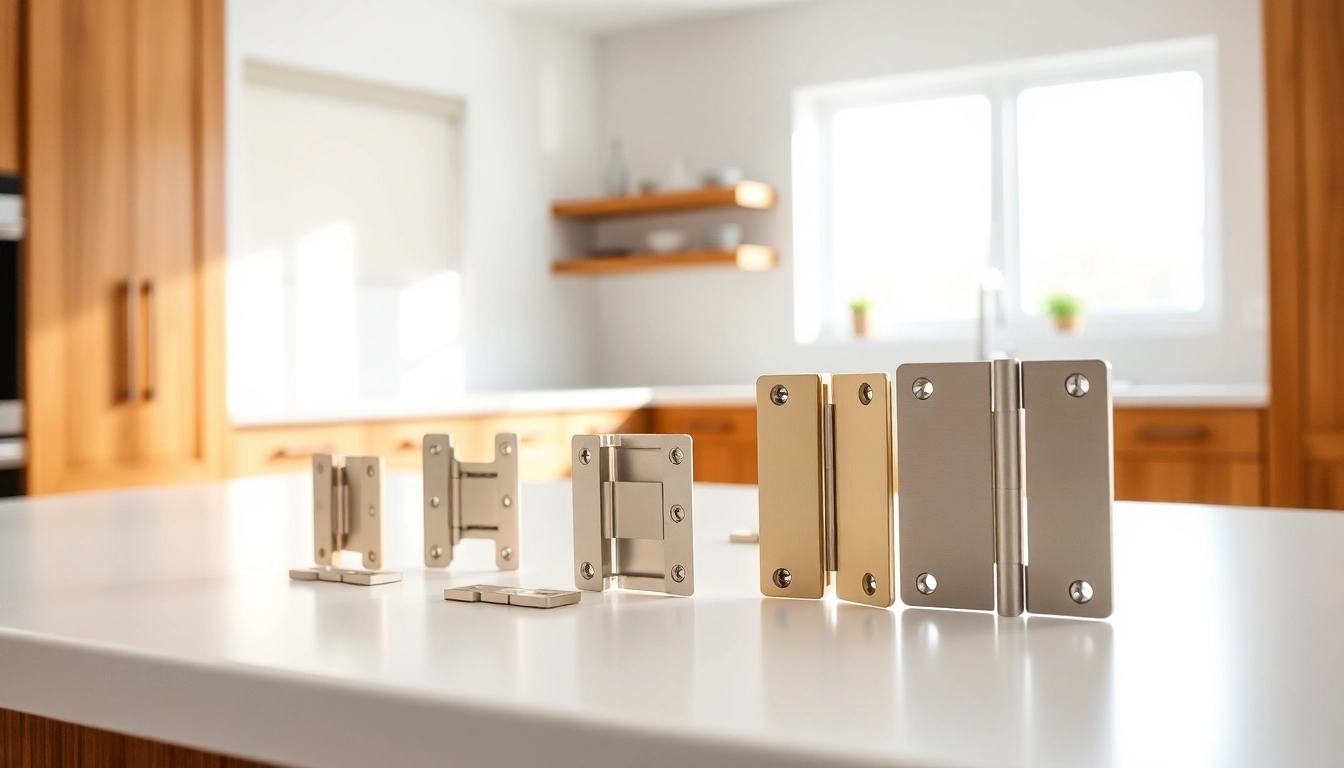Understanding Cabinet Hinges
When it comes to cabinetry, the unsung heroes that keep your doors functioning smoothly and your kitchen looking sleek are cabinet hinges. These essential components not only support the door’s weight but also determine how it opens and closes, impacting both the usability and aesthetic appeal of cabinets. For a comprehensive exploration of what cabinet hinges entail, it’s vital to delve into their various types, the mechanisms by which they operate, and the materials utilized by cabinet hinge manufacturers.
Types of Cabinet Hinges
Cabinet hinges come in a variety of styles, each designed to serve specific applications and preferences. Understanding the different types can help you make informed choices for your cabinetry. Here are some common types:
- Overlay Hinges: These are used when the cabinet doors overlap the cabinet frame, providing a seamless look.
- Inset Hinges: Inset hinges are designed for cabinets where the door sits inside the cabinet frame. This hinge type is ideal for traditional cabinetry.
- Concealed Hinges: Often referred to as European hinges, these are hidden from view when the door is closed, creating a clean aesthetic.
- Pivot Hinges: Used mainly for larger cabinet doors, pivot hinges allow for a smooth, controlled movement and are typically mounted at the top and bottom of the door.
- Soft-Close Hinges: These specialized hinges feature damping mechanisms that slow the door’s closure for a soft landing, preventing slamming and extending the cabinet’s lifespan.
How Cabinet Hinges Work
The functioning of cabinet hinges is often taken for granted, yet their operation is crucial for the longevity and functionality of cabinetry. At their core, hinges allow doors to pivot on a fixed point. Most hinges consist of two plates that are attached to the cabinet and the door, respectively.
When it comes to concealed hinges, they employ a clever design that allows them to remain hidden from view. A spring-loaded mechanism controls the opening and closing motion, ensuring that the doors close softly and quietly. Understanding how these mechanisms work is vital for both installation and maintenance.
Materials Used in Manufacturing Cabinet Hinges
The durability and effectiveness of cabinet hinges are influenced largely by the materials used in their construction. Here are common materials:
- Steel: Steel is widely used for its strength and durability. However, it can be prone to rust, so it’s often coated with finishes such as zinc or chrome.
- Stainless Steel: Unlike regular steel, stainless steel is corrosion-resistant, making it suitable for humid environments like kitchens and bathrooms.
- Brass: Known for its aesthetic appeal, brass is often used for decorative hinges. It is also resistant to tarnishing.
- Plastic: Sometimes, hinges made of high-quality plastic are utilized. They are lightweight and resistant to moisture but may not be suitable for heavier doors.
Choosing the Right Cabinet Hinge
Choosing the appropriate hinge involves understanding various factors that influence its performance and suitability for specific applications. Here’s what you need to consider:
Factors to Consider When Selecting Hinges
When selecting cabinet hinges, consider the following aspects:
- Weight of the Door: Heavier doors require stronger hinges. Verify the load capacity when making your selection.
- Cabinet Type: The style and layout of the cabinet (overlay or inset) will dictate the type of hinge needed.
- Desired Functionality: If quiet closing is a priority, opt for soft-close hinges. For wider openings, consider pivot hinges.
- Finish Matching: Ensure the hinge finish complements the overall look of the cabinetry.
Popular Cabinet Hinge Brands and Their Features
Several manufacturers are renowned for their high-quality cabinet hinges, each offering unique features:
- Blum: Known for their soft-close technology and durability, Blum hinges are a top choice among professionals.
- Grass: Offers innovative designs, including the popular “Dynapro” hinges, which are both strong and elegant.
- Amerock: Provides a variety of styles and finishes, emphasizing both form and function in their hinge designs.
- Sugatsune: Specializes in advanced engineering and aesthetic designs, appealing to high-end cabinetry.
Comparing Prices and Performance of Different Hinge Types
When considering hinges, it’s essential to compare not just prices but performance metrics as well. For instance, while a basic hinge may be cheaper upfront, investing in higher-quality soft-close hinges may save you money in the long run due to their durability and lower maintenance costs. Evaluate customer reviews and performance ratings to identify the best value for your needs.
Industry Insights from Cabinet Hinge Manufacturers
As trends evolve, cabinet hinge manufacturers adapt their products to meet changing consumer demands. Here are insights into current industry trends and innovations.
Market Trends in Cabinet Hardware
The market for cabinet hinges is growing, influenced by the increasing focus on ergonomic design and sustainability. Key trends include:
- Smart Hinges: Technological advancements have given rise to smart hinges that integrate with home automation systems.
- Sustainable Materials: Eco-friendly materials and finishes are becoming a priority for manufacturers in response to consumer demand.
- Customization: An increasing preference for bespoke cabinetry means that many manufacturers now offer customizable hinge options.
Innovations and Technologies in Hinge Manufacturing
Today’s hinge manufacturing industry is characterized by innovation, such as:
- Improved Fluid Mechanics: Enhancements in dampening technology have produced hinges that close more quietly and smoothly.
- Modular Designs: Some manufacturers are developing hinge systems that allow for easy adjustment and replacement.
- Automation in Manufacturing: The use of robotics and advanced manufacturing technologies is streamlining production processes, resulting in better quality control.
Case Studies from Leading Manufacturers
Some leading manufacturers have made significant strides in hinge design and functionality. For example, a company like Blum has set the standard with its range of soft-close products, effectively reducing wear and tear on cabinets.
Another notable case is Grass, which rolled out its “Tiomos” hinge system, featuring a sophisticated closing mechanism. By understanding these case studies, other manufacturers can glean insights into effective product development strategies.
Installing Cabinet Hinges: A Step-by-Step Guide
Proper installation is key to ensuring that cabinet hinges function effectively. Here’s a step-by-step guide to help you through the process:
Tools Required for Installation
Before starting, ensure you have the necessary tools:
- Screwdriver (preferably a power screwdriver)
- Drill with appropriate drill bits
- Measuring tape
- Level
- Pencil for marking
Common Mistakes to Avoid When Installing Hinges
Installing hinges may seem straightforward, but several common pitfalls should be avoided:
- Misalignment: Make sure to measure accurately to prevent misalignment, which can cause doors to stick or not close properly.
- Inadequate Screwing: Using screws that are too short or over-tightening them can compromise the hinge’s performance.
- Ignoring Manufacturer’s Instructions: Always refer to the specific installation guidelines provided by the manufacturer.
Maintenance Tips for Long-Lasting Hinges
After installation, maintaining your hinges is critical for ensuring longevity and performance. Here are some tips:
- Regularly clean hinges with a damp cloth to remove dirt and debris.
- Apply a light lubricant, such as silicone spray, to prevent squeaking and ensure smooth operation.
- Inspect hinges periodically to check for signs of wear or corrosion, especially in areas with high humidity.
Evaluating Performance and Durability Standards
Before choosing hinges, evaluating their performance and durability is crucial to ensure they will meet your needs. Manufacturers often provide data on testing procedures and how their products have performed under various conditions.
Testing Procedures for Cabinet Hinges
Common testing procedures include:
- Load Testing: This determines the weight a hinge can support before failing.
- Cycle Testing: Hinges are opened and closed repeatedly to simulate long-term performance wear.
- Corrosion Testing: Exposed to saline or moisture, these tests measure rust resistance.
Warranty and Support from Cabinet Hinge Manufacturers
Many manufacturers offer warranties that guarantee their hinges for a specific period. Understanding the terms of these warranties can help you gauge the manufacturer’s confidence in their product. Some manufacturers also provide customer support for installation or maintenance inquiries, making it easier for you to resolve issues that may arise.
Customer Reviews and Feedback on Hinge Durability
Lastly, reviewing customer feedback on hinge durability can give valuable insights into their performance in real-world applications. Websites and forums where users discuss their experiences enable you to compare various products and make informed decisions.



